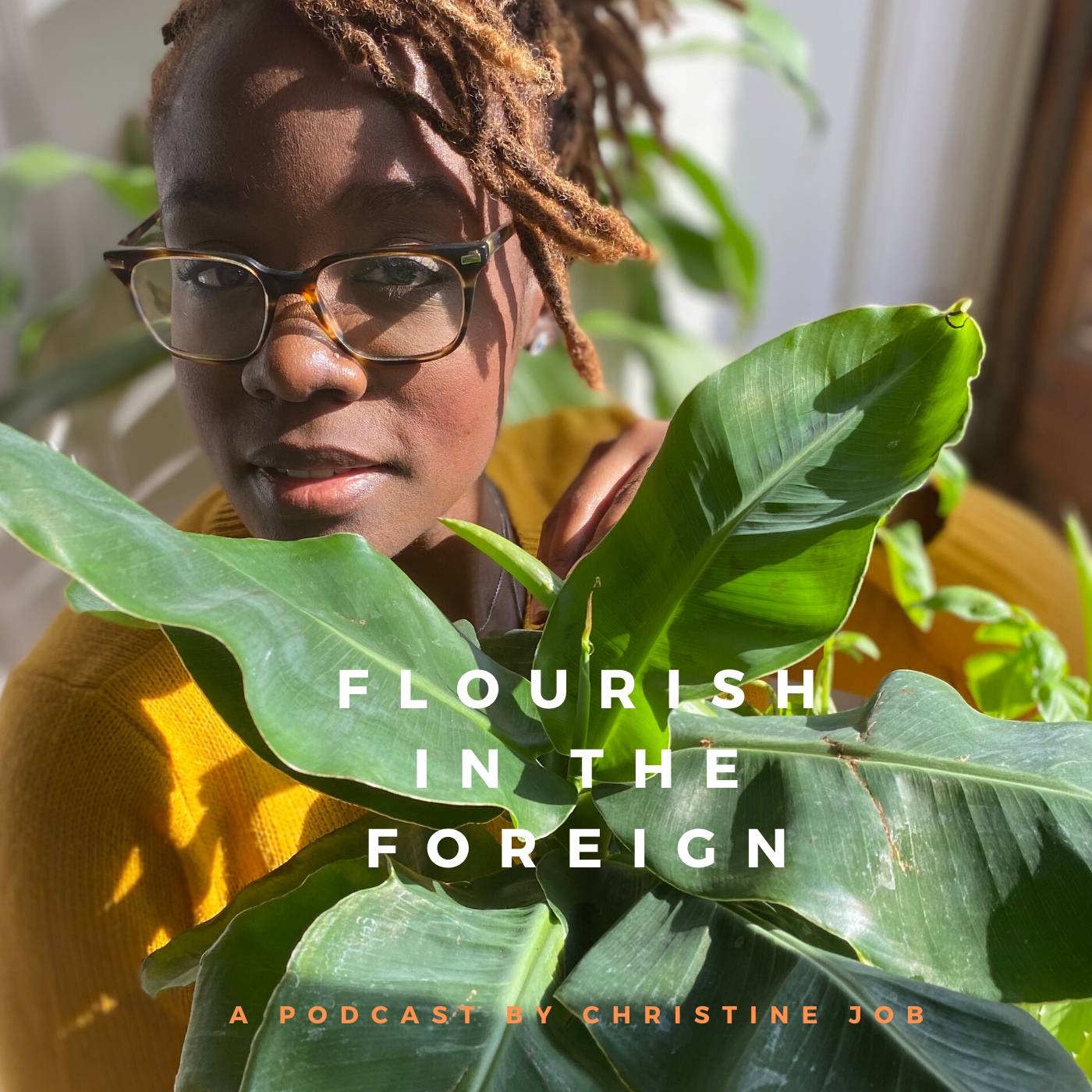Welcome Home: An African Jamaican living in Ghana
One of my Ghanaian colleagues said, “But you are not African.” I said, “If I am not African, then what am I?” He said, “Jamaican” feebly.
By: Dr. Rachel V. Brown
All my life I’ve had to fight…
I sat with some co-workers and professed my deep love for Africa. I told them how glad I was to finally be home. One of my Ghanaian colleagues said, “But you are not African.” I said, “If I am not African, then what am I?” He said, “Jamaican” feebly, sensing my pain. Then I snapped, “Look at my skin, my hair, my nose, my lips, my hips; there is no denying that I am African. I am Jamaican but I am also African. I may not have been ‘born in Africa but Africa was born in me’”. He laughed and apologized. I know he may have forgotten by now, but I will never forget. Just like how I will never forget all of the affirmations I have received from my people that I look like them, cook like them, and am one of them. Just like I will never forget the peace I finally feel because I am finally back home, where I belong.
7 months ago, I made the biggest move of my life and I moved home; not home as in where I was born or grew up or where my parents are, or the past (although I suppose in some way it is the past that’s past the past), but home as in my present and future.
I was born in Kingston, Jamaica, left at 16 on a scholarship to a school in the US, and since then I have lived in a bunch of countries and seen a good chunk of the world. My whole life, I’ve been searching for home. I’ve waited patiently for a place that would not be temporary; a place I could grow some roots and where better to put down roots than the place of my roots which is where I am now: Ghana. I am home.
I fell in love with this country long before I came here. I knew this place intimately before I set foot in this space. And way before I decided to visit or move, way before any planes landed, I was present here and I knew I belonged. Those who know me well were not surprised when I told them that my new home would be Accra.
My connection to this land is other-worldly. I get flashbacks to places I’ve never been to in this lifetime. Everything feels familiar. And it isn’t because it looks and feels ridiculously a lot like Jamaica (which is another blog post all together), but because I’m sure I’ve been here before somehow, perhaps while I was stored in the hearts and minds of my ancestors who were here, or perhaps, in a past life. This was and is home.
When I got to the airport and they were checking my passport, they asked what the purpose of the trip was and I proudly said, “I’m moving here.” They responded with what I’ve longed to hear, “Welcome home.” And while part me wondered if they say that to all the Black people coming back or really knew that this experience was special for me and that I belonged here, I chose to just believe what I wanted to and go with them acknowledging my powerful ancestral roots within and truly being happy that I had returned to them.
I understand that our return has had pros and cons in every single industry and aspect of society. While diasporans are spending a lot and supporting local businesses, a lot of prices have been raised because they can afford to pay more. Even in the housing market, the prices have inflated beyond anything affordable for the majority of the population and are now comparable to or higher than rent in the US and Europe, and exponentially higher than other countries on the continent. While it has been great that Ghana has gotten so much positive attention, the increase in people here has led to an increase in things like traffic (which is crazy here) and overall crowding in the city. Many roads have been paved and buildings have been created or renovated to appeal to “outsiders”. Most of that construction and renovation has taken place in cities like Accra and Kumasi while other parts of the country have been neglected. Families who have lived here for generations are having to move out of the city because they can’t afford to stay here. With these in addition to numerous other examples of the dichotomy created, I can understand why there are different reactions to me being here; however, that doesn’t change the fact that sometimes the negative or skeptical reactions hurt.
What I’ve noticed is that many of the people here know how much returning means to us. I mean there was a whole Year of Return and subsequently the Beyond the Return movement has taken root in Ghana with many other countries adopting their own version. However, there seems to be different feelings towards us and this concept of returning. Sometimes I feel like Ghanaians born and living here are truly happy that I am home, and other times I feel like the “other” and as if this whole return is a joke to them. As someone who was expecting and hoping to be embraced like a child who had been kidnapped and by some miracle survived and made her way back home, and as someone who has been constantly aware of that kidnapping and intentionally and actively rejected the Stockholm syndrome, it is painful when I am treated as if or perceived as an outsider in my own home.
Because of that I have tried desperately to become more like a chameleon but how can one blend in when they are clearly and proudly different? How can one blend in when you are born to stand out? Ironically, many of the things that I thought would help me blend have been the things that indicate that I was born elsewhere. When I lived in predominantly white countries, getting any form of African food was a treat and I would try to have it as much as I could afford to (which was rarely). Now, I cannot eat banku or fufu or jollof more than maybe once every few weeks because I’ve had and seen them so often. I went to Kumasi and had fufu with light soup for 5 days straight and I have no desire to see fufu ever again. Some people seem to never tire of it. I realize I only like to explore and eat different foods from different places sparingly. I go out and I dance to the music without thinking; music is a soul connection. And while people are sometimes shocked that I know the latest Afrobeats moves, they also see that I move differently. Just last week I went to a dancehall party and someone came up to me and said “I can tell you’re Jamaican by the way you move.” That just made me proud because I love Jamaica and that I’m from there. (name a Jamaican that is not proud to be Jamaican…I’ll wait) Another surprise has been the reception of my clothing. When I step out in my African prints looking like the empress I am, the first question people ask is “Where are you from?” Apparently, my dresses are a giveaway which is ironic because I’ve worn them my whole life with pride as a way of outwardly showing that I was not only African genetically but celebrated that Africanness by choice. Here in Africa, they indicate that I am “not African” or from somewhere else. *face palm* African print is worn but not worn most days by most people and certainly not in the styles I wear it. I will wear my African empress dresses proudly regardless because they are beautiful and African. Also, I’m just not a big fan of jeans….
I’m still pretty new to my home and although it has always been a part of me, naturally, I’ve been trying to figure out where and how I am a part of it.
I have to tread gently and carefully on shaky legs…a near impossible feat. My mission and purpose in life is to ensure that I make things better for my people so I am eager to get to work here and help to improve the country; however, I recognize that “improvement” is subjective and don’t want to step on any toes. And while I know that Ghana is mine and I am Ghana’s, I have been away from her all my life and would be remiss if I assumed that I could make improvements without more knowledge, guidance, support, and consent from my brothers and sisters here. All this is to say, it has been a lot to navigate and a lot to process. It hasn’t been easy, but I have never doubted once that I belong here and to be honest, I would rather things be challenging in a space where I love and I belong than the many other places I have lived before that were also challenging but were never home.
Dr. Rachel V. Brown is a Philanthropist, Education Strategist and Communication Specialist who currently lectures at the Ghana Institute of Journalism. In addition to lecturing at GIJ, she is also the COO of Steady/X, a virtual education platform. In 2020, she earned her PhD from Universitat Autònoma de Barcelona with a thesis focusing on the impact of Social Media Activism, she earned her Master's degree in Law from Wake Forest University, and her Bachelor’s degree in Communication with a minor in Spanish from the University of Southern California. She is the Co-founder and Executive Director of the Every Mikkle Foundation, a youth-based and youth-led non-profit which she started with her friends in 2013. Her work has taken her to 31 countries where she has conducted projects in many fields including education, STEM, ending hunger, environmental sustainability, youth advocacy, women's empowerment, health, culture, the performing arts, and sports. In 2019 she was named one of the Caribbean's 30 under 30. In 2021 she was also appointed as a World Food Forum Champion by the FAO. Dr. Brown is an activist who believes we have the power and duty to heal, protect, and restore our earth and its people by first educating others and then implementing impactful changes.
Reflections on How Living Abroad Influences Home Decor Style
Before moving to Japan, I had never lived on my own. Growing up in my parents’ house, I got to see my mother express herself.
By: Annabell Stubbs
“How living in Japan has influenced your home decor style?”
The lovely host and creator of Flourish in the Foreign Christine asked me this question and I found it thought-provoking in so many ways. It offset a chain reaction of questions, answers, and further questions in my mind. It forced a sort of self-reflection I hadn’t considered on my own, so I’m grateful to her for the question.
As an architectural designer, I’ve never thought of myself as having a particular style. Especially regarding decor. To many architects, decor is a dirty word. About design styles in general though, sometimes I feel pressure from my peers in the field to define my style, my stance.
I’m still on a journey of discovery when it comes to this topic, so this blog is more of a self-exploration than a direct answer.
Living in Jamaica:
My Parents’ House & Architecture School
Before moving to Japan, I had never lived on my own. Growing up in my parents’ house, I got to see my mother express herself through the periodical changes she made to the interior decor.
Since I have no experience of living solo in Jamaica to compare my current one with, I can only reference my early ideas on design which surfaced in architecture school. I did my Bachelor of Arts in Architectural Studies at the University of Technology, Jamaica. In any architecture school around the world, you will learn about the history and elements of architectural styles.
I won’t bore you with an architectural history lesson, but do bear with me while I raise a few points that influenced my way of thinking as a designer.
In architecture school, we learned the tenets of modernism. Modernism as an architectural style resonated with me. A simple summary of the tenets would be;
Buildings should reflect the technology of their era, much like cars and cell phones do.
Ornamentation as seen in classical European architectural styles is at best, unnecessary. At worst, it is ostentatious, expensive, and hides rather than celebrates the brilliant engineering that actually makes buildings what they are. By this I mean, putting a swirly design over the connection between a column and a roof. Modernism celebrates those joints, exposing them for all to see. No frills.
These tenets affirmed my desire for Jamaica to diverge from the use of classical European architecture to signal class, power, so-called high culture, and beauty. I grew to despise any and all ornamentation. This transferred to my views on interior decor. (I am not so dogmatic now.)
In my opinion, at the time, almost everything in a typical interior was unnecessary. Honestly, I just found it easier to think out issues of functionality, rather than beauty. Designing for function gave me something to work with, what I can and cannot do. It was technically more complex but philosophically, pretty simple. Beauty was just too subjective for me. There is no right or wrong in interior design. The truth is it intimidated me, though I couldn’t admit it back then. I just boiled it down to interior decor being unimportant and focused on developing more technical skills in architectural design.
Living in 5 Different Apartments
Across 3 Prefectures in Japan
Even I get confused with the trajectory of my life since moving to Japan in the summer of 2013.
I’ll try to break it down in this timeline. Forgive the CV format.
2013-2015
Ishikawa Prefecture, hard winters
I taught English and got put up by my school in a pretty spacious 2LK (2 bedroom, living, kitchen, 1 bathroom) apartment. Everyone who visited me there commented that it looked like I just moved in. I didn’t get any new furniture and got rid of some of the stuff provided. Anyone who visited would’ve thought I was a minimalist.
I didn’t attempt to, nor had the desire to personalize the space. Teaching English was always gonna be a temporary gig. The sole objective was to save as much money as possible. Buying anything for the sake of interior decor was a waste of money, as far as I was concerned. If anything, my money went to the electricity bills. Japanese apartments are made of thin walls with no insulation or central heating. Being spacious as it was, it was even more difficult to keep it warm.
2015-2019
From Kanagawa Prefecture to Central Tokyo
From 2015 to 2019 I lived in three progressively smaller apartments. The first one I lived in while in school. It was a 6m2 (64 sqft) room with the tiniest shower room and kitchenette imaginable attached to it. The next two were sharehouses, with shared kitchens, and bathrooms. The horror stories I could tell...
Eifukucho Share House
2019-Present
Still in Tokyo
My current place isn’t perfect, it’s not as spacious and beautiful as my first one in Ishikawa, but it is mine and it feels like home. Maybe I needed the experience of the three horrible apartments in between this and the first. They made me appreciate every square meter of space I have now. They taught me that, a lot of Jamaicans may have it better than they think. They taught me through lived experience, the dos and don’ts of tiny living. Mostly, they taught me that tiny living is not for me, and I wouldn’t believe the hype if I were you. Just my humble opinion though.
This apartment is about 30m2 (322 sqft), pretty well laid out, and easy to use for the most part. I low-key hate the bathroom but, this is Japan.
Designing My Space
Function
Having been stuck in glorified broom closets from 2015 to 2019, I gained a serious appreciation for the separation of functions. I don’t want to eat, sleep, write my thesis, design buildings, and watch Netflix in the same space.
My first non-negotiable was that I was going to have a bedroom. I would do nothing but sleep in that room. Next, a dedicated workspace separate from where I relax. Furniture-wise, this meant getting a desk. I was happy to lounge on the floor in my downtime, but my boyfriend convinced me to get a very comfortable couch. Definitely did not regret that purchase. Otherwise, there’d be no coffee tables, side tables, or frills, just the essentials. The space is bigger, yes, but 30m2 (322 sqft) is still not that big. And furniture can make a space feel smaller than it is really quickly. Low-key, I’m starting to see how a coffee table would be nice, but we’ll see.
Colour and Materiality
My apartment has convincing faux wood flooring. It’s a lighter hue imitation wood, so I decided all my furniture would be made of light wood. Light colours help small spaces look bigger because they bounce light around. If any fabrics were involved, they would be light too. My bedsheets are white, my couch a light green. The flat white surface of the bed reflects the light from the balcony doors and projects it further into the deep narrow apartment. I didn’t trust myself with beige or white for the couch, because stains.
Furniture I Designed & Made
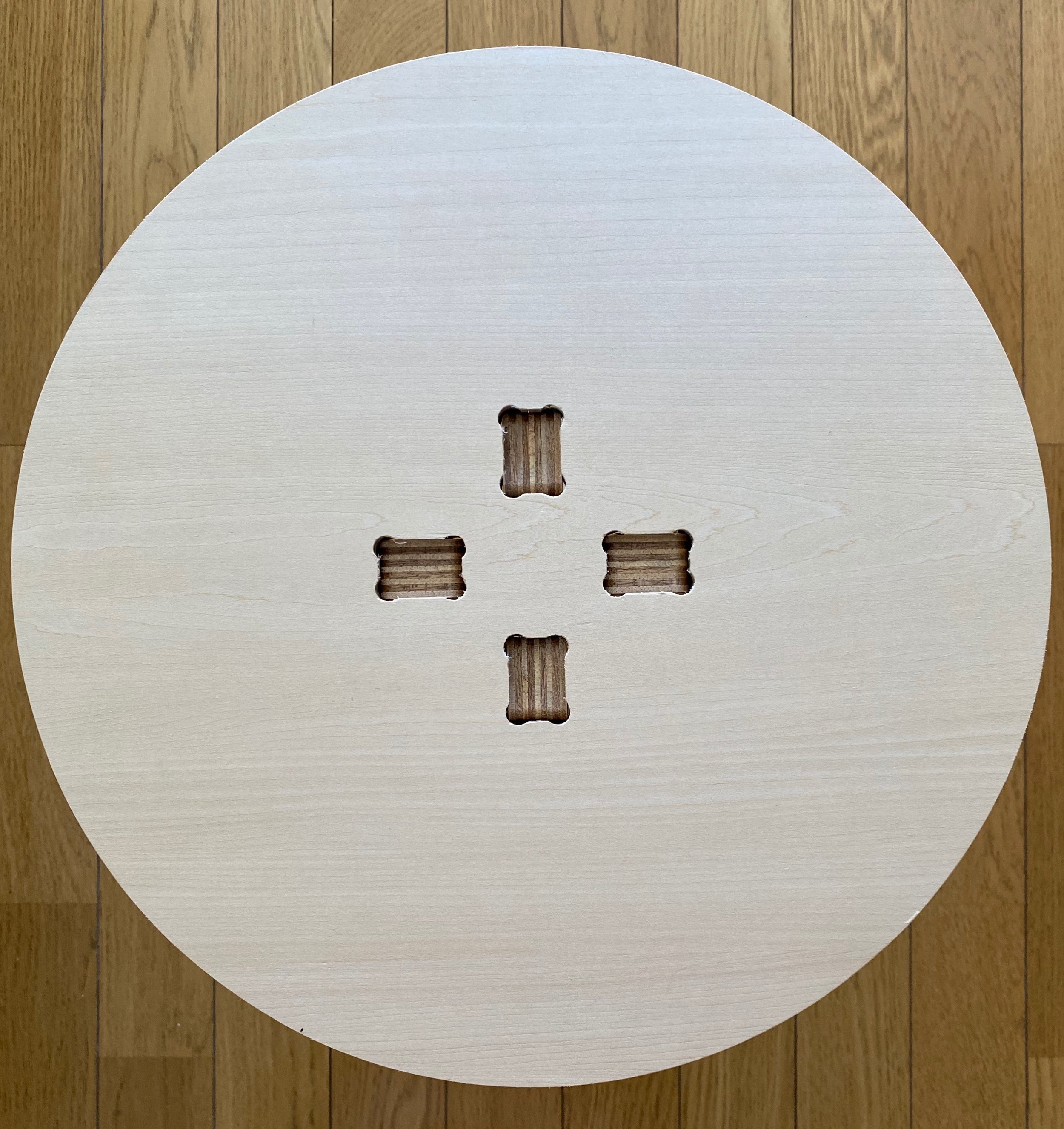

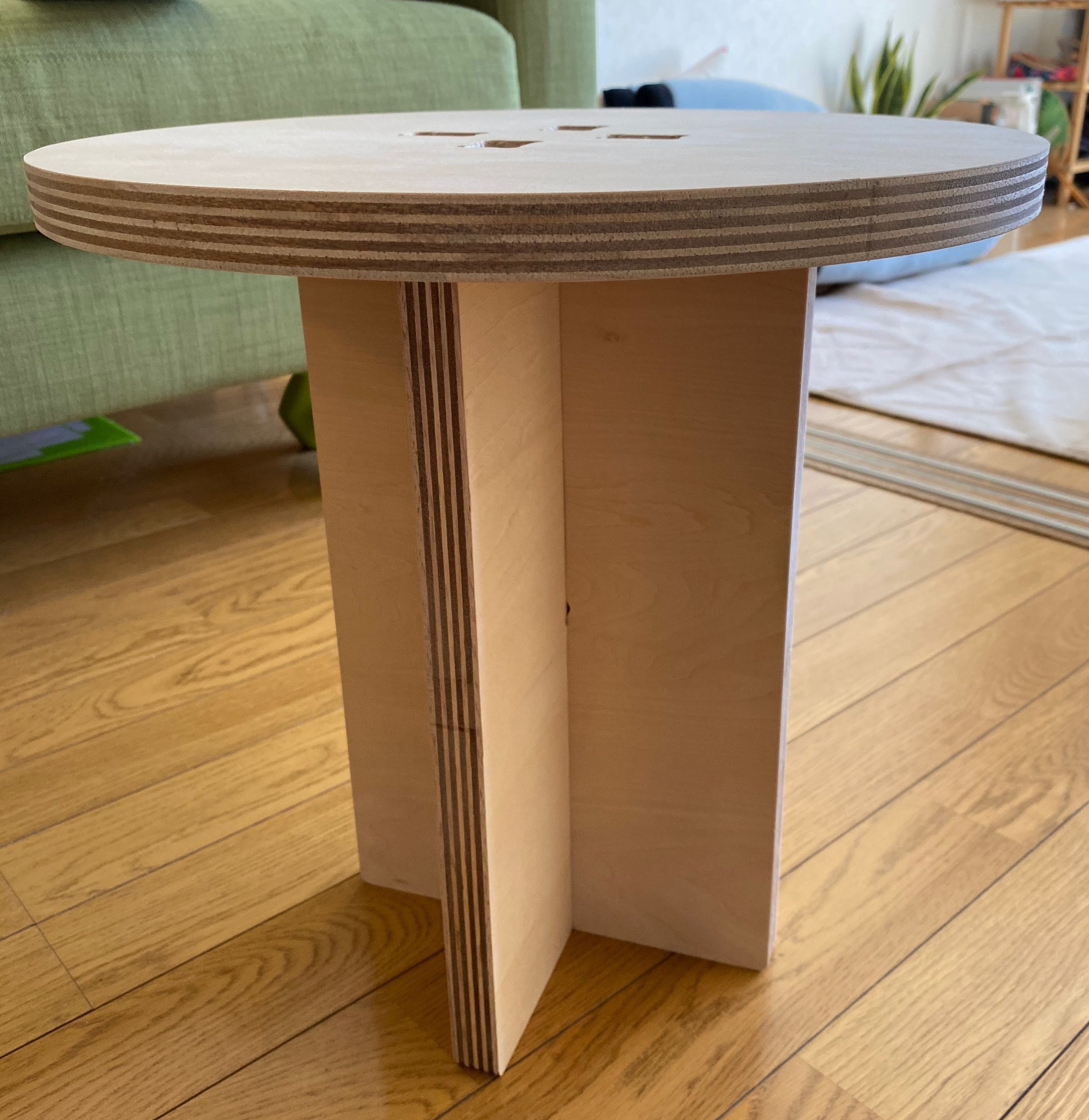
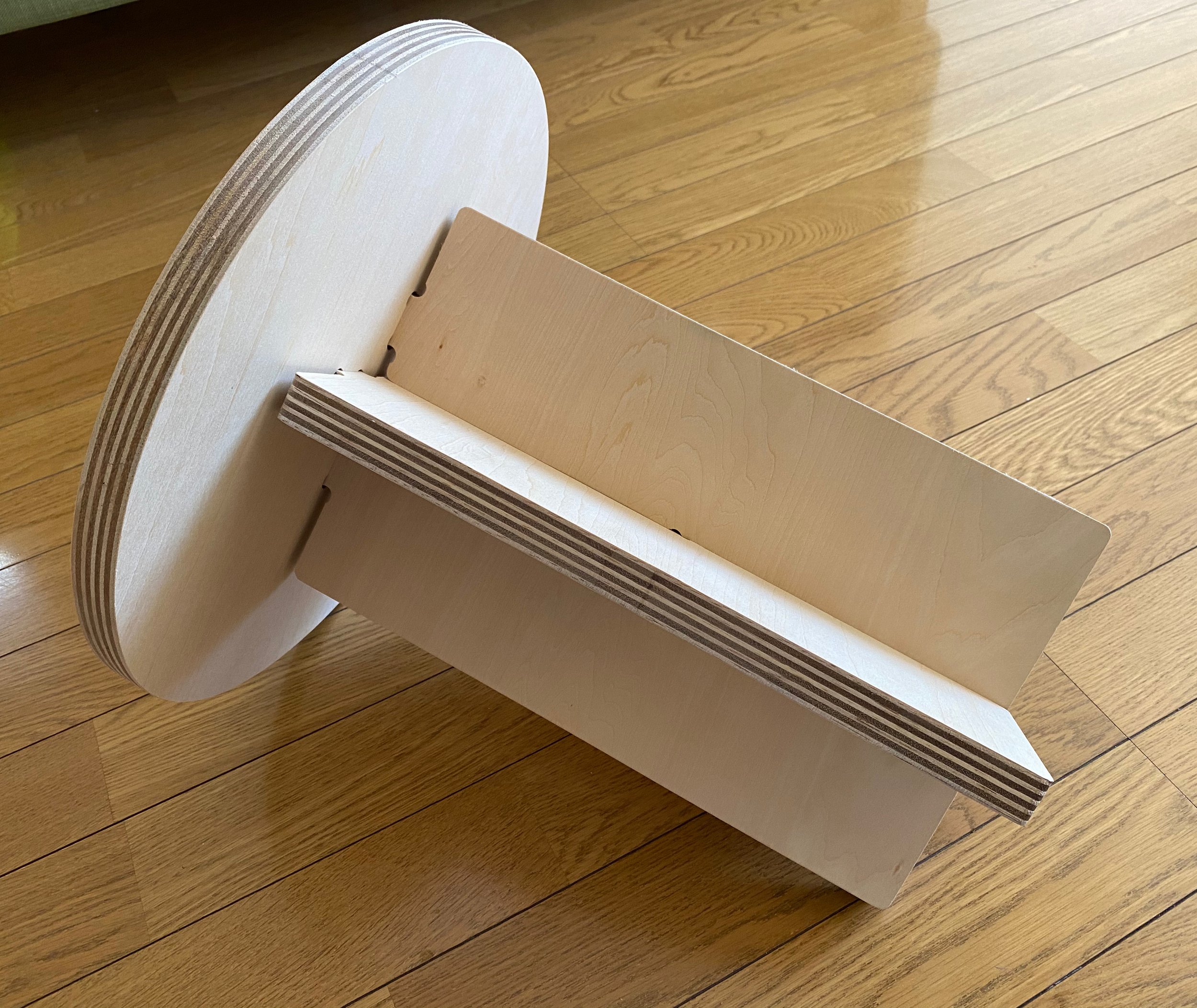

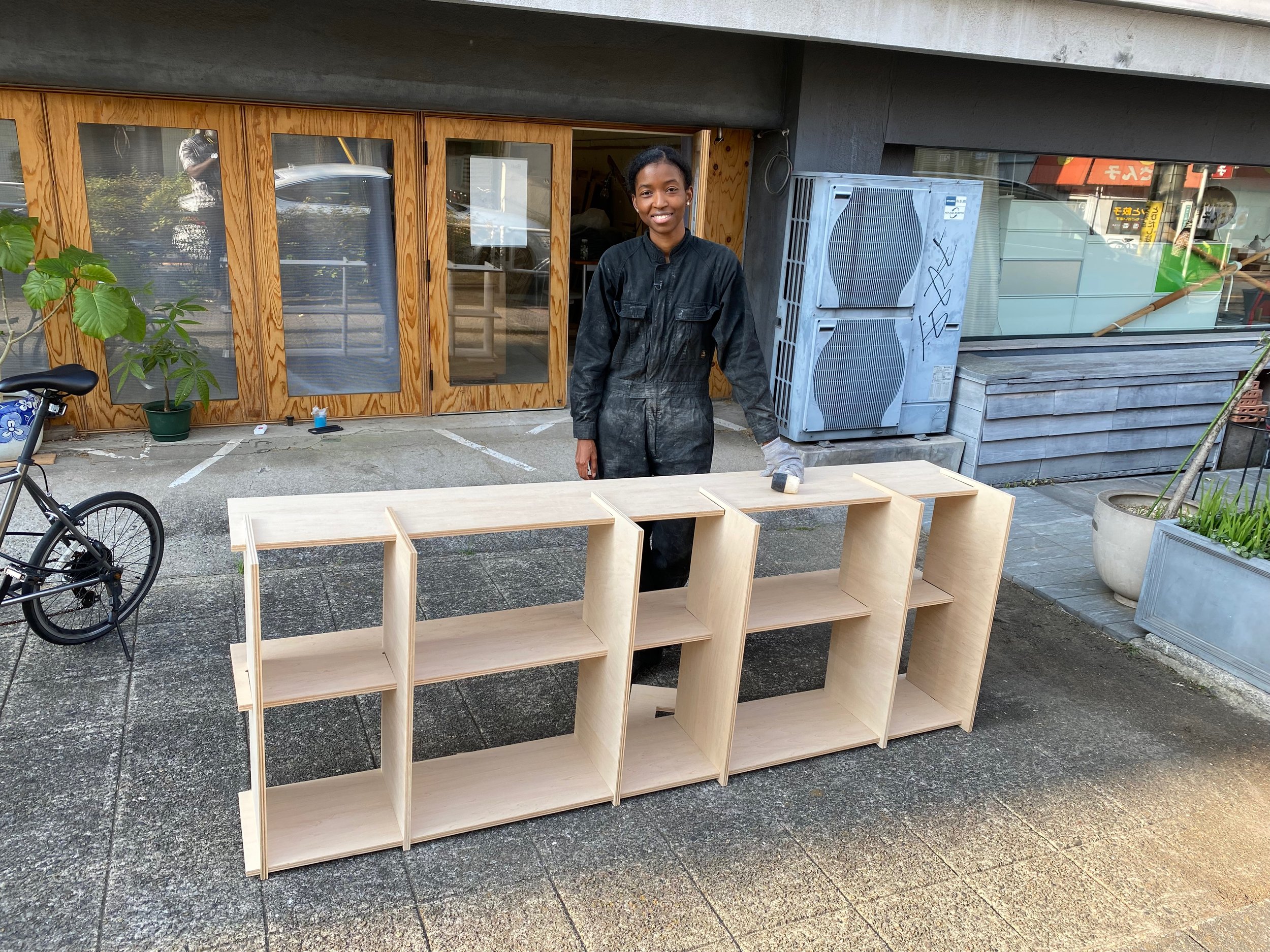
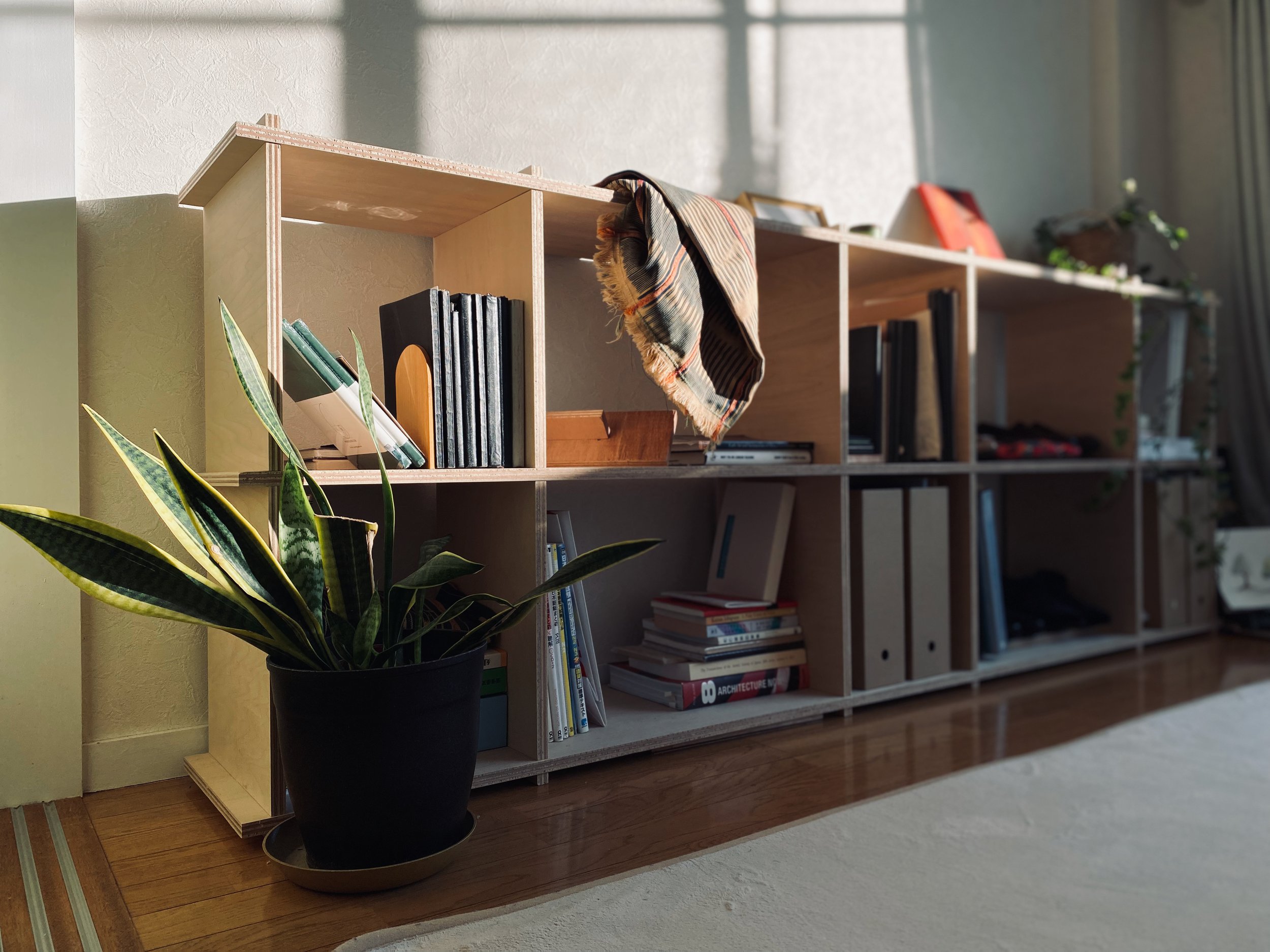
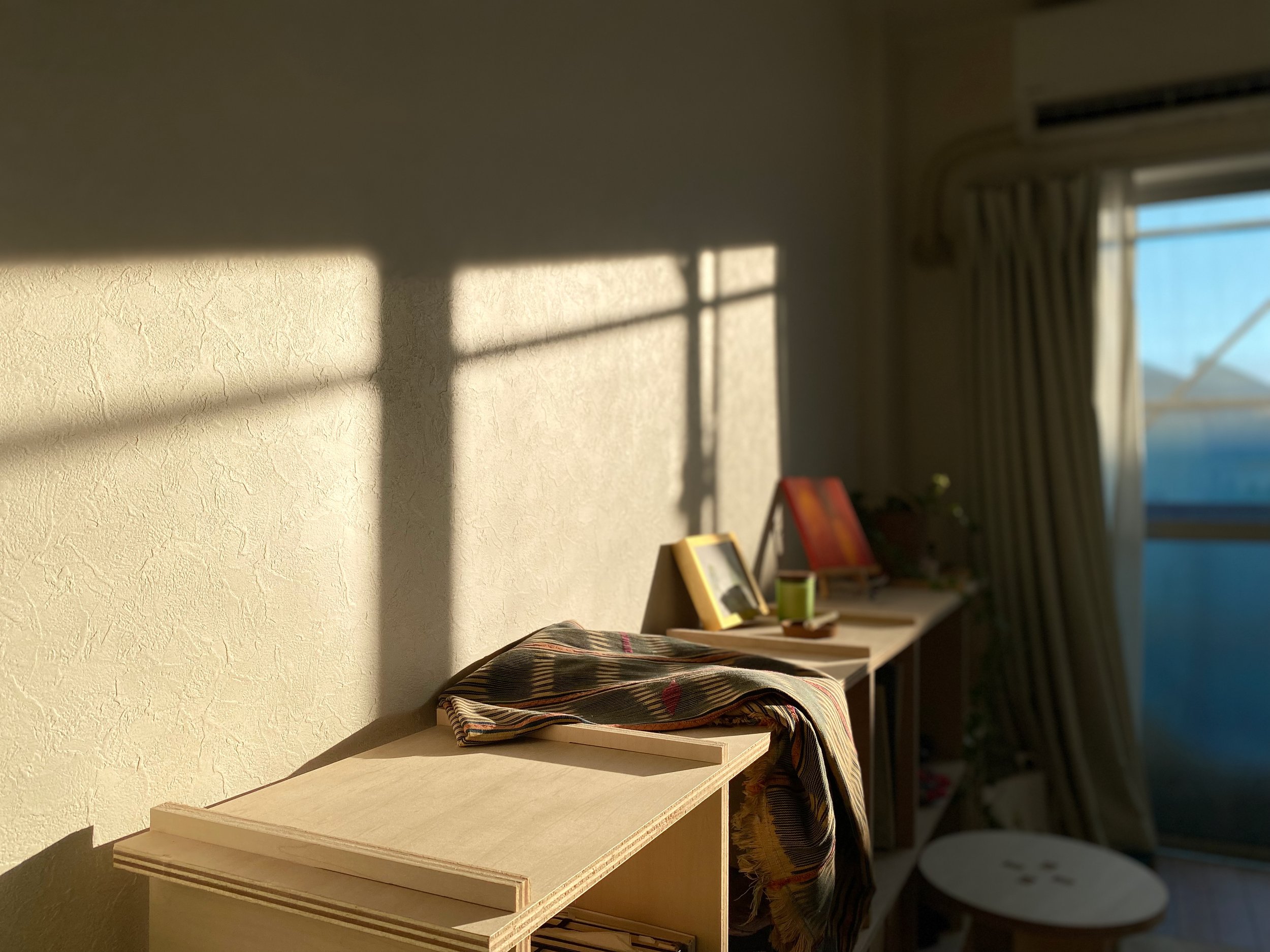
I think it would take another blog post to explain how I learned the skills I used to make the three stools and bookshelf I now have in my apartment. But I have my time at Keio University to thank for it. I also think I’d need to write a separate article to explain the process of designing each and how the space I live in dictated their outcomes. I can say, they follow the dos and don'ts of tiny living that I mentioned earlier.
Light-Coloured Wood
In this case, high-quality furniture-grade ply made from Linden wood.
A form and assembly driven by function, meant to display the technology used to make them.
Leaving the ridges on the surface, rather than making it a continuous level counter-top type, invites questions. Exposing them creates opportunities to explain how the shelf was made with slotted joinery, without nails, screws, or glue.
Dimensions
The length, height, and depth of the shelf and my stools were determined by the proportions of my own body, the size of the rooms they would be used in, and their relationship to furniture I already had in these rooms.
No backboard
For visibility of the wall behind it, making the presence of the shelf more subtle. Important in a small space. It’s more flexible without a front and a back. It has no defined direction.
Without a back, it can be used in the middle of a space, not just against a wall.
So,
Do I have a Style?
If I do have a style, it is guided by my process. A process of responding to real-world conditions.
In one case, I might measure the length of my thigh and calf to determine the diameter for the seat and height of a stool. In another case, I might measure the distance from my bed to an opposing wall, to tell me the maximum depth for my bookshelf. That is, a depth that would leave me space to walk in what I feel is a comfortable way.
Maybe it’s all not as logical as I think. I’m sure a lot of it is visceral. Tenets of modernism aside, I love wood. The fact that modernism demands that we expose materials instead of hiding them could be just a happy coincidence.
If I had a different space, in a different country, I’m sure the aesthetic would be very different from the one I’ve slowly developed here. While I am definitely not a minimalist, I’m also really uncomfortable with excess and clutter.
My style is more like a base formula. With different variables, there’ll be different results. With the combination of my tendency to respond to circumstance and to only want what’s necessary, I’d dare to hope that my style could be called appropriate.
I was born and raised in Jamaica, where my journey to becoming an architect began. I’m currently an architectural designer at Japan’s largest architectural firm.
Check out Annabell's episode on Flourish in the Foreign here.
Watch the IG Live featuring Annabell here.
Have some insight to share? Drop your comments below and let’s continue the conversation.
Found this helpful? Be sure to share with your friends!
